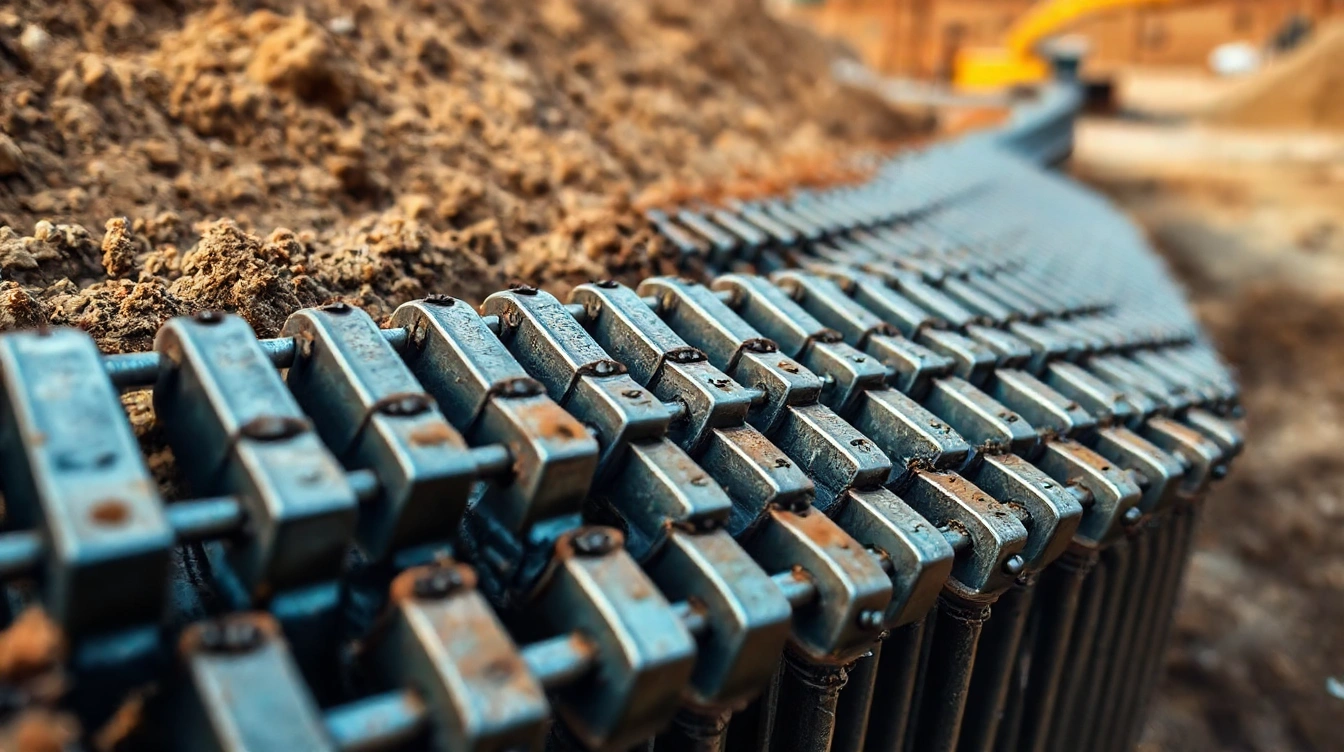Secant pile walls offer a robust solution for managing earth retention challenges in complex construction sites. By interlocking reinforced and unreinforced piles, these walls provide exceptional stability and waterproofing, adapting well to diverse soil and groundwater conditions. Understanding their design, construction, and practical advantages reveals why secant pile walls often outperform traditional retaining structures in urban and infrastructure projects.
Understanding Secant Pile Walls as Earth Retention Systems
Key to effective geotechnical engineering
Dans le meme genre : Discover our mission and values at anchorless
Secant pile walls are a specialized type of retaining structure widely used in geotechnical engineering for earth retention purposes. These walls consist of a series of interlocking concrete piles, placed sequentially to form a continuous barrier that supports excavations and prevents soil collapse. The primary feature that distinguishes secant pile walls is the method of construction piles are cast in overlapping fashion, ensuring tight joints and enhanced stability.
In practice, secant pile walls function by creating a strong, impermeable barrier that resists lateral earth pressures. The overlapping piles interlock to transfer soil and water loads effectively to the ground, maintaining excavation integrity in challenging soil conditions or where groundwater control is necessary. This makes secant pile walls ideal for deep excavations near existing infrastructure.
A découvrir également : Top budget-friendly storage options for businesses in glasgow
The main components involved include:
- Primary piles, typically constructed of unreinforced concrete, which create the initial structural framework.
- Secondary piles, reinforced with steel, are installed between primary piles and overlap them, enhancing strength and impermeability.
- The use of high-quality concrete and sometimes waterproofing additives contributes to the wall’s durability.
Understanding these features clarifies why secant pile walls are highly regarded in earth retention for their reliability and adaptability in complex geotechnical projects. For comprehensive construction insights, refer to Secant Pile Wall Construction Solutions.
Construction Process of Secant Pile Walls
Understanding the step-by-step approach
The construction sequence of secant pile walls begins with thorough site preparation, ensuring a stable foundation for piling techniques. Precise surveying and setting out the pile locations lay the groundwork for efficient installation.
Secant pile wall installation involves drilling overlapping cylindrical piles into the ground. Initially, primary piles often unreinforced are installed using wet or dry drilling methods depending on soil and groundwater conditions. These piles serve as a structural base and are constructed with bentonite slurry or casing to prevent collapse.
Following this, secondary piles are drilled and placed between the primary piles. These secondary piles are typically reinforced with steel cages and poured concrete to achieve the interlocking secant wall structure. The sequencing of installing primary and secondary piles is critical; overlapping ensures continuous earth retention and structural integrity as the wall progresses.
Successful piling techniques require specialized equipment such as rotary drilling rigs, excavation support systems, and concrete tremie pipes. Skilled operators and geotechnical engineers collaborate closely to maintain pile alignment, depth, and quality. This expertise ensures the secant pile wall installation meets design specifications, balancing effective earth retention with project efficiency.
Advantages of Secant Pile Walls Over Alternative Retention Methods
Exploring why secant pile walls are a preferred choice in modern construction
Secant pile walls offer distinct advantages compared to other earth retention systems like diaphragm walls. Their design inherently provides superior groundwater control, essential for projects dealing with challenging soil conditions or high water tables. The interlocking nature of secant piles creates an almost impermeable barrier, significantly reducing water ingress and thereby protecting excavation sites more effectively than many traditional methods.
From a structural flexibility standpoint, secant pile walls adapt well to various soil types, including loose or heterogeneous soils, which often pose difficulties for alternative systems. This adaptability means they can be engineered to accommodate differing load requirements and site constraints, providing a customized solution that enhances safety and performance.
When comparing secant vs diaphragm walls, one must note that secant pile walls can be constructed more rapidly and with less noise, making them advantageous in urban environments or sites with access limitations. Additionally, the construction process allows for greater control over pile depth and alignment, optimizing stability for deep excavations.
The versatility in design and installation methods makes secant pile walls highly suitable for complex projects where groundwater control and soil variability are concerns. These advantages solidify their role as an effective, efficient choice in earth retention strategies.
Key Applications in Construction and Infrastructure Projects
Secant pile walls offer versatile applications critical to various infrastructure projects. They are especially valuable in situations requiring robust earth retention and excavation support in challenging environments.
Commonly, secant pile walls are employed in urban excavation projects where space constraints and existing structures demand minimal disturbance. Their ability to create a continuous, load-bearing barrier makes them ideal for deep basements beneath high-rise buildings or tight city plots.
These walls are also widely utilized in transportation infrastructure, such as tunnels and bridge abutments, where stable lateral support is essential. Additionally, in industrial settings, secant pile wall uses include protecting heavy machinery foundations or retaining slopes on confined sites.
Design considerations for secant pile walls depend on soil conditions, depth requirements, and load characteristics. For example, in deep basements, interlocking piles provide watertight retention to prevent groundwater ingress. For infrastructure projects near sensitive utilities, precise alignment and construction sequence must be planned thoroughly.
For tailored solutions, project professionals often explore Secant Pile Wall Construction Solutions to balance stability, cost-efficiency, and construction timeframe in complex environments. This comprehensive approach helps maximize the benefits of secant pile walls across diverse construction scenarios.
Technical Performance and Cost-Effectiveness
Secant pile walls are engineered with precise design criteria to ensure optimal load capacity and structural integrity. The wall thickness is a crucial factor, directly impacting both the capacity to withstand earth pressures and the overall material use. Generally, thicker walls enhance load-bearing capacity but may increase construction costs, necessitating a balanced approach tailored to project requirements.
Cost considerations extend beyond initial construction expenses. Factors such as excavation complexity, site conditions, and reinforcement needs influence the total investment. However, secant pile walls often prove cost-effective over the project’s lifecycle due to their superior durability and adaptability.
Regarding long-term performance, secant pile walls demonstrate remarkable resistance to soil and water pressures, reducing the need for frequent maintenance. Their robust structural capacity contributes to enhanced lifecycle durability, minimizing repair interventions and associated costs. Choosing secant piles based on detailed design criteria ensures both technical excellence and economic efficiency throughout the wall’s service life.
Real-World Examples and Case Studies
Real-world project examples of secant pile walls showcase their adaptability and effectiveness in diverse construction environments. One notable aspect derived from multiple case studies is the consistent performance of secant pile walls in providing robust earth retention, even under complex soil and groundwater conditions. These projects highlight the walls’ ability to maintain stability during excavation, minimizing settlement and ensuring site safety.
Performance analysis from these case studies often points to several benefits: reduced construction time, enhanced structural integrity, and cost efficiencies compared to alternative methods. For instance, in urban settings with limited space, secant pile walls have enabled deep excavations without compromising adjacent structures—demonstrating practical solutions for tight project constraints.
However, lessons learned reveal challenges such as the importance of precise pile alignment and quality control during installation. Expert reviews emphasize that meticulous design and execution are critical for optimal outcomes. Addressing potential issues early, like soil heterogeneity or groundwater pressures, can prevent expensive remediation.
For construction teams and engineers looking to leverage this method, understanding these real-world experiences is invaluable. The insights drawn from case studies provide a blueprint for navigating typical project hurdles while maximizing the advantages of secant pile walls.













